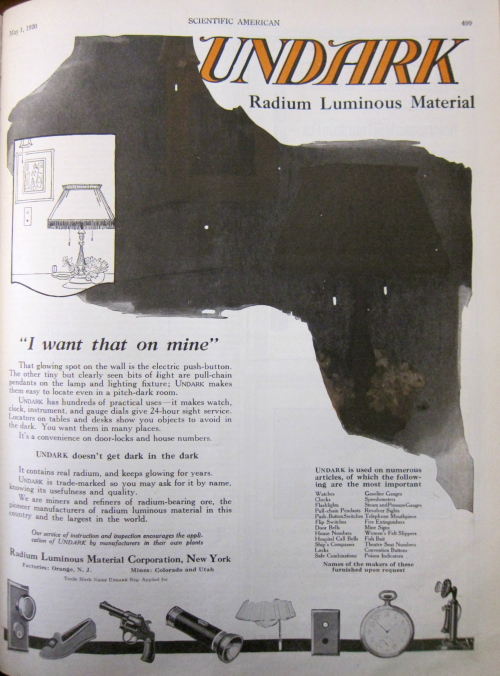JF Ptak Science Books Quick Post
Undark.
 Now, that is quite a name for a product--for a glow-in-the-dark product, for something that will not darken. The advertisement displayed here was for a product that "doesn't get dark in the dark", and appeared in the Scientific American on May 1, 1920. The particularly cringeworthy part of Undark, viewed from the future of this advertisement, is that the spots of light on the wall and etc. that make Undark what it was was an applied radium paint. And it was the famous or infamous case of "The Radium Girls" (that really brings the cringe into sharp focus, as it was this same company and product that was being advertised (left) that brought all of those workers into their sometimes-lethal encounter).
Now, that is quite a name for a product--for a glow-in-the-dark product, for something that will not darken. The advertisement displayed here was for a product that "doesn't get dark in the dark", and appeared in the Scientific American on May 1, 1920. The particularly cringeworthy part of Undark, viewed from the future of this advertisement, is that the spots of light on the wall and etc. that make Undark what it was was an applied radium paint. And it was the famous or infamous case of "The Radium Girls" (that really brings the cringe into sharp focus, as it was this same company and product that was being advertised (left) that brought all of those workers into their sometimes-lethal encounter).
[It is a little difficult to make out what is going on in that dark patch, but essentially it is the room at left, in the dark, and the little specks of white are the items on which the Undark has been painted. So if you needed to find the fobs of a lamp or the edge of a table or a gun in the dark, Undark will get you there.]
The women were workers for the U.S. Radium Corporation--which started out its business life as the Radium Luminous Materials Corporation--who worked with radium and luminous paints and who contracted radiation poisoning from their close contact (and ingestion) of the paint, a result of "sharpening" their paint brush tips by touching it to their lips and tongues. The injurious effects of radium was well known to the chemists and executives at U.S. Radium, but that information was kept from the women hired to apply the paint to (in this case) watch dials.
Historic litigation ensued in the early 1920's, and when the case was settled in 1928 the workers received relatively modest settlements--the result of the case though was wide-reaching in labor rights law and also in occupational health and safety--all of that was a lot more valuable than the $10k payment and $660/year annuity awarded to the Radium Girls.
Evidently the inventor of the first radium-based luminescent paint, Sabin Arnold von Scohocky (1883-1928) developed aplastic anemia (a developing deficiency and failure to produce all three blood cell types) most probably as a result of his prolonged exposure to radioactive material. Marie Curie, Max Valier, Otto Lillienthal (and so on) also died as a result of working on their discoveries/breakthroughs, though what ultimately cost von Scohocky his life was nowhere near as significant as the work of the other three.


Comments